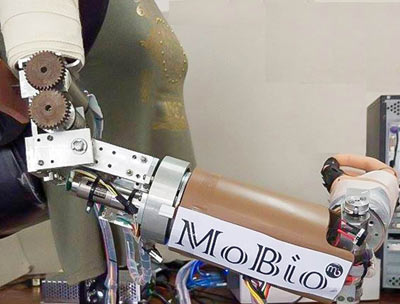Robotic Prosthetic Arm developed by University of Moratuwa to help war victims
View(s): In the background of Sri Lanka’s once-raging civil war and the casualties arising out of it, a group of final year students and faculty members of Department of Mechanical Engineering at University of Moratuwa (UoM) has, for the first time, developed an artificial robot-arm to assist amputees. Presently, various research groups all over the world also carry out similar studies to produce artificial upper-limbs for the needy who have been amputated due to congenital disorders, tumours, neuroma, accidents and infections. In line with these developments using world-renowned technologies a novel robotic prosthetic arm known as ‘MoBio’ was designed as an outcome of the project at the UoM, a spokesperson for the team that developed the arm, told the Business Times. The robot-arm is designed for a transhumeral amputee whose amputation has occurred between the shoulder and the elbow joints.
In the background of Sri Lanka’s once-raging civil war and the casualties arising out of it, a group of final year students and faculty members of Department of Mechanical Engineering at University of Moratuwa (UoM) has, for the first time, developed an artificial robot-arm to assist amputees. Presently, various research groups all over the world also carry out similar studies to produce artificial upper-limbs for the needy who have been amputated due to congenital disorders, tumours, neuroma, accidents and infections. In line with these developments using world-renowned technologies a novel robotic prosthetic arm known as ‘MoBio’ was designed as an outcome of the project at the UoM, a spokesperson for the team that developed the arm, told the Business Times. The robot-arm is designed for a transhumeral amputee whose amputation has occurred between the shoulder and the elbow joints.
The spokesperson said that as a result of the civil war which continued over a period of three decades Sri Lanka is a country suffered both economically and sociologically. Post-war development activities are currently underway to uplift the country’s infrastructure and quality of life of its people. In particular, war causalities have been the focal group, including military and civilians, who have been greatly affected not only psychologically but also physiologically. There are considerable numbers of amputees who have lost their upper-limbs (entirely or partially) and are in need of assistance to manage their activities of daily living (ADL), he said. The main obstacle faced by the amputees is that wearable and active prosthetic arms are rare and their functionality is poor in comparison to the cost.
Furthermore, degrees of freedom (DOF) of the existing prosthetic upper-limbs are less than the actual human arm. The MoBio prosthetic arm uses the electromyographic (EMG) signals of the remaining biceps and triceps muscles of the amputee to enable five DOF motions. This arm can do the elbow flexion/extension, forearm supination/pronation, wrist flexion/extension, ulnar/radial deviation and compound motion of the thumb and first fingers. “These motions are activated sequentially by triggering the motion through a sudden high amplitude muscle signal pulse. Furthermore, extents of motion are controlled through the muscle signals of the same biceps and triceps muscles,” he said. As the first stage, feasibility of the MoBio prosthetic arm was tested using a healthy human subject.
In the next stage clinical tests should be carried out with the assistance of a transhumeral amputee. The project has been carried out by Mechanical Engineering undergraduates – Achintha Abayasiri, Nilupa Peduru Arachchige and Tharindu Sadeepa under the guidance of Dr. Ruwan Gopura, senior lecturer at Department of Mechanical Engineering, University of Moratuwa and D.G. Kanishka Madusank, a PhD candidate at Department of Mechanical Engineering, University of Moratuwa. The working prototype was successfully demonstrated on April 25 and 26l at the department premises during a mini-exhibition of the Design and Research projects of final year undergraduates. The spokesperson said that Sri Lanka is currently reaching new dimensions of the latest technology in the globe, and it is believed that this project work is one of huge steps in achieving that goal.


